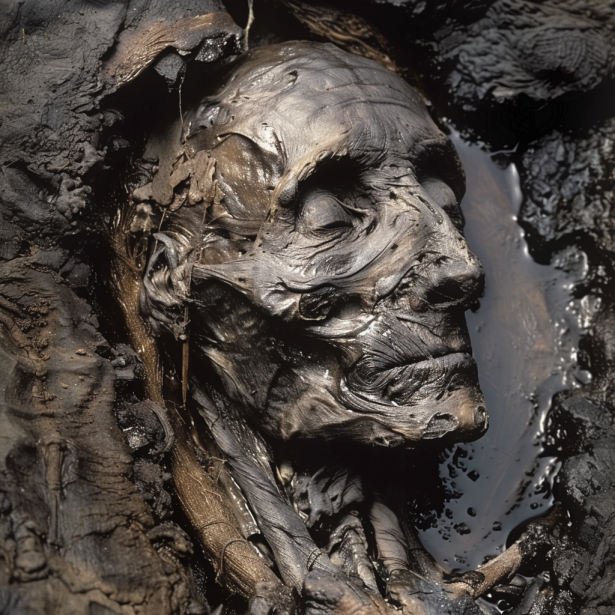Introduction
Ancient bog bodies, naturally preserved in the peat bogs of Northern Europe, offer a fascinating and eerie glimpse into the past. These mummified remains, dating back to the Iron Age, have been discovered with remarkable details intact, from their skin and hair to their last meals. Famous examples such as the Tollund Man and the Lindow Man reveal much about the lives and deaths of these ancient individuals. Often showing signs of violent deaths, these bodies suggest ritualistic sacrifices or executions. The preservation of these bodies has allowed scientists to study their clothing, health, diet, and the circumstances of their deaths, shedding light on the rituals, beliefs, and daily life of ancient cultures.
The Discovery of Bog Bodies
Bog bodies have been found primarily in the peat bogs of Denmark, Germany, the Netherlands, the United Kingdom, and Ireland. The unique conditions of these bogs, characterized by low temperatures, low oxygen levels, and high acidity, create an environment that preserves organic material remarkably well. These discoveries often happen accidentally during peat cutting or excavation work.
Famous Bog Bodies
The Tollund Man
Discovered in 1950 in Denmark, the Tollund Man is one of the most well-preserved bog bodies. He was found wearing a pointed cap and a noose around his neck, suggesting he was hanged. Radiocarbon dating indicates he lived around 400 BCE. The exceptional preservation allowed scientists to study his facial features, last meal, and cause of death.
The Lindow Man
Found in 1984 in England, the Lindow Man is another well-known bog body. He lived during the 1st century CE and showed signs of a violent death, including a blow to the head, a garrote around his neck, and a cut across his throat. His well-preserved remains provided insights into his diet, health, and the possible ritualistic nature of his death.
Other Notable Finds
Other significant bog bodies include the Grauballe Man, the Yde Girl, and the Haraldskær Woman. Each of these bodies has provided unique information about the individuals and the societies they belonged to, highlighting various aspects of Iron Age life and death.
Ritualistic Deaths and Sacrifices
Many bog bodies show evidence of violent deaths, leading researchers to believe they were victims of ritualistic sacrifices or executions. The precise nature of these rituals remains a topic of debate, but some theories suggest they were offerings to gods or spirits, punishments for crimes, or deaths related to social or political events.
Insights into Daily Life
Health and Diet
Analysis of the stomach contents and isotopic composition of bog bodies has provided detailed information about their diet. For example, the Tollund Man’s last meal consisted of porridge made from grains and seeds, typical of an Iron Age diet. Studies of teeth and bones have revealed insights into their health, nutrition, and physical activity.
Clothing and Appearance
The clothing found on bog bodies, such as woolen garments and leather accessories, offers valuable information about the materials, weaving techniques, and fashion of the time. The well-preserved hair and skin also allow scientists to study grooming practices and personal appearance.
Social and Cultural Context
The artifacts found with bog bodies, such as tools, weapons, and personal items, provide clues about the social status, occupation, and cultural practices of these individuals. The context of their burial suggests complex belief systems and social structures.
Scientific Techniques in Bog Body Research
Modern scientific techniques have revolutionized the study of bog bodies. These include:
- Radiocarbon Dating: Used to determine the age of the remains.
- CT Scans and MRI: Provide detailed internal images without damaging the bodies.
- DNA Analysis: Offers insights into genetic ancestry, health conditions, and familial relationships.
- Isotope Analysis: Helps reconstruct diet, migration patterns, and environmental conditions.
Cultural and Historical Significance
Bog bodies are not only valuable to scientists but also hold cultural and historical significance. They provide a direct connection to the past, offering a tangible link to ancient peoples and their ways of life. The study of bog bodies helps to fill gaps in our understanding of prehistoric Europe, particularly regarding Iron Age societies.
Preservation and Ethical Considerations
The preservation of bog bodies presents ethical challenges. Respecting the remains and the cultures they represent is paramount. Museums and researchers must balance scientific inquiry with ethical considerations, ensuring that the treatment and display of bog bodies honor their historical and cultural significance.
Conclusion
The ancient bog bodies of Northern Europe offer a unique and detailed glimpse into the past. Their exceptional preservation allows scientists to study various aspects of Iron Age life, from diet and health to clothing and social practices. The evidence of ritualistic deaths provides intriguing insights into the beliefs and rituals of ancient cultures. As research continues, these bog bodies will undoubtedly reveal even more about the mysterious and fascinating world of our ancestors.
FAQs
What are bog bodies?
Bog bodies are naturally mummified human remains found in peat bogs, primarily in Northern Europe, dating back to the Iron Age.
How are bog bodies preserved?
The unique conditions of peat bogs, including low temperatures, low oxygen levels, and high acidity, preserve organic material such as skin, hair, and clothing.
What is significant about the Tollund Man?
The Tollund Man is one of the best-preserved bog bodies, discovered in Denmark in 1950. His remains provide detailed insights into his appearance, last meal, and cause of death.
Why do many bog bodies show signs of violent deaths?
Many bog bodies show evidence of violent deaths, suggesting they were victims of ritualistic sacrifices or executions, though the exact reasons remain a topic of debate.
What can we learn from the diet of bog bodies?
Analysis of stomach contents and isotopic composition reveals information about their diet, health, and nutrition, providing a glimpse into Iron Age eating habits.
What ethical considerations are involved in studying bog bodies?
Respecting the remains and the cultures they represent is crucial. Researchers and museums must balance scientific inquiry with ethical considerations, ensuring respectful treatment and display of bog bodies.

